Spatiotemporal Patterns and the Development Path of Land-Use Carbon Emissions from a Low-Carbon Perspective: A Case Study of Guizhou Province
Abstract
:1. Introduction
2. Overview of the Study Area and Data Sources
2.1. Overview of the Study Area
2.2. Data Sources
3. Research Methods
3.1. Dynamic Model of Land Use
3.2. Land-Use Carbon Emissions Calculation Model
4. Results
4.1. Spatiotemporal Evolution of Land Use
4.2. Spatiotemporal Pattern Analysis of Land-Use Carbon Emissions
4.3. Spatiotemporal Pattern Analysis of Land-Use Carbon Emissions Intensity
4.4. Analysis of Carbon Emissions per Capita
4.5. Analysis of Combined Spatial Difference between Emissions and Efficiency
5. Discussion
5.1. Analysis of Land-Use Change
5.2. Analysis of Low-Carbon Development Path
5.2.1. Promote the Optimization of Industrial Structure
5.2.2. Guide the Rational Distribution of Population
5.2.3. Improve Relevant Policies and Systems
6. Conclusions
- (1)
- Cultivated land and construction land in Guizhou Province have undergone the most significant changes in recent years. Construction land showed a trend of continuous expansion, and its main source was cultivated land. Guizhou Province is located in the mountainous region, with the area of forest land accounting for more than half of its total area. Forest land fulfils strong ecosystem functions and is the primary source of the carbon sink.
- (2)
- From 2009 to 2019, carbon emissions intensity in Guizhou Province continued to decline, while total carbon emissions and carbon emissions per capita maintained an upward trend. Accelerating urbanization, energy structure transformation, the immoderate utilization of land by human beings, and the increasing population density were the key causes of the significantly increasing trend in carbon emissions in Guizhou Province.
- (3)
- From the perspective of the cities in Guizhou Province, there were obvious spatial differences in carbon emissions and carbon emissions efficiency. Because of variations in land-use and economic growth patterns, Guiyang was the only high emission–high efficiency city, and Bijie was the only low emission–high efficiency city. Over time, the carbon emissions per capita and carbon emissions intensity in the different regions also exhibited agglomeration effects.
Author Contributions
Funding
Data Availability Statement
Acknowledgments
Conflicts of Interest
References
- Masson-Delmotte, V.; Zhai, P.; Pirani, A.; Connors, S.L.; Péan, C.; Berger, S.; Caud, N.; Chen, Y.; Goldfarb, L.; Gomis, M.I.; et al. IPCC, 2021: Climate Change 2021: The Physical Science Basis; Cambridge University Press: Cambridge, UK; New York, NY, USA, 2021; p. 2391. [Google Scholar]
- Lee, C.C.; Huang, K.C.; Kuo, S.Y.; Cheng, D.K.; Tung, C.P.; Liu, T.M. Climate change research in Taiwan: Beyond following the mainstream. Environ. Hazards-Hum. Policy Dimens. 2023, 22, 79–97. [Google Scholar] [CrossRef]
- An, N.; Yao, Q.; Shen, Q.J. A review of human settlement research on climate change response under carbon-oriented: Literature characteristics, progress and trends. Buildings 2022, 12, 1614. [Google Scholar] [CrossRef]
- Redlin, M.; Gries, T. Anthropogenic climate change: The impact of the global carbon budget. Theor. Appl. Climatol. 2021, 146, 713–721. [Google Scholar] [CrossRef]
- Wang, M.M.; Kong, D.Z.; Mao, J.H.; Ma, W.J.; Ayyamperumal, R. The impacts of land use spatial form changes on carbon emissions in Qinghai–Tibet Plateau from 2000 to 2020: A case study of the Lhasa metropolitan area. Land 2023, 12, 122. [Google Scholar] [CrossRef]
- Kang, T.T.; Wang, H.; He, Z.Y.; Liu, Z.Y.; Ren, Y.; Zhao, P.J. The effects of urban land use on energy-related CO2 emissions in China. Sci. Total Environ. 2023, 870, 161873. [Google Scholar] [CrossRef] [PubMed]
- Zhai, P.M.; Yuan, Y.F.; Yu, R.; Guo, J.P. Climate change and sustainable development for cities. Chin. Sci. Bull. 2019, 64, 1995–2001. [Google Scholar] [CrossRef]
- Lin, Q.W.; Wang, S.S.; Li, Y.C.; Riaz, L.; Yu, F.; Yang, Q.X.; Han, S.J.; Ma, J.M. Effects and mechanisms of land-types conversion on greenhouse gas emissions in the Yellow River floodplain wetland. Sci. Total Environ. 2022, 813, 152406. [Google Scholar] [CrossRef]
- Zhang, K.; Shen, J.; Zhang, J.; Han, H. Recent advances on renewable energies and carbon capture. Pol. J. Environ. Stud. 2019, 28, 2541–2552. [Google Scholar] [CrossRef] [PubMed]
- Li, J.S.; Guo, X.M.; Chuai, X.W.; Xie, F.J.; Yang, F.; Gao, R.Y.; Ji, X.P. Reexamine China’s terrestrial ecosystem carbon balance under land use-type and climate change. Land Use Policy 2021, 102, 105275. [Google Scholar] [CrossRef]
- Sleeter, B.M.; Marvin, D.C.; Cameron, D.R.; Selmants, P.C.; Westerling, A.R.; Kreitler, J.; Daniel, C.J.; Liu, J.X.; Wilson, T.S. Effects of 21st-century climate, land use, and disturbances on ecosystem carbon balance in California. Glob. Chang. Biol. 2019, 25, 3334–3353. [Google Scholar] [CrossRef]
- Bridhikitti, A.; Ketuthong, A.; Prabamroong, T.; Li, R.Z.; Li, J.; Liu, G.H. How do sustainable development-induced land use change and climate change affect water balance? A case study of the Mun River Basin, NE Thailand. Water Resour. Manag. 2023, 37, 2737–2756. [Google Scholar] [CrossRef]
- Zhang, Y.Q.; Luo, H.L.; Wang, C. Progress and trends of global carbon neutrality pledges. Clim. Chang. Res. 2021, 17, 88–97. [Google Scholar]
- Xi, J.P. Note on the Proposal of the Central Committee of the Communist Party of China for Formulating the 13th Five-Year Plan for National Economic and Social Development. Communist 2015, 23, 9–13. [Google Scholar]
- Yang, P.G.; Liang, X.; Drohan, P.J. Using Kaya and LMDI models to analyze carbon emissions from the energy consumption in China. Environ. Sci. Pollut. Res. 2020, 27, 26495–26501. [Google Scholar] [CrossRef] [PubMed]
- Hepburn, C.; Qi, Y.; Stern, N.; Ward, B.; Xie, C.P.; Zenghelis, D. Towards carbon neutrality and China’s 14th Five-Year Plan: Clean energy transition, sustainable urban development, and investment priorities. Environ. Sci. Ecotechnol. 2021, 8, 100130. [Google Scholar] [CrossRef] [PubMed]
- Huang, Q.F. The key stage of the great rejuvenation: Learning the understanding and experience of the 14th Five-Year Plan for National Economic and Social Development of the People’s Republic of China and the Outline of the 2035 Vision Goals. People’s Trib. 2021, 15, 6–10. [Google Scholar]
- Xu, D. The issuance of the “1+N” policy system constitutes the top-level design of China’s realization of the “Dual Carbon” goal. Int. Pet. Econ. 2022, 30, 24–26. [Google Scholar]
- Sun, M.Y.; Li, X.H.; Yang, R.J.; Zhang, Y.; Zhang, L.; Song, Z.W.; Liu, Q.; Zhao, D. Comprehensive partitions and different strategies based on ecological security and economic development in Guizhou Province, China. J. Clean. Prod. 2020, 274, 122794. [Google Scholar] [CrossRef]
- Liu, M.; Chen, Y.R.; Chen, K.; Chen, Y. Progress and hotspots of research on land-use carbon emissions: A global perspective. Sustainability 2023, 15, 7245. [Google Scholar] [CrossRef]
- Zhou, M.; Ma, Y.X.; Tu, J.T.; Wang, M.C. SDG-oriented multi-scenario sustainable land-use simulation under the background of urban expansion. Environ. Sci. Pollut. Res. 2022, 29, 72797–72818. [Google Scholar] [CrossRef]
- Tang, M.G.; Hu, F.X. How does land urbanization promote CO2 emissions reduction? Evidence from Chinese prefectural-level cities. Front. Environ. Sci. 2021, 9, 766839. [Google Scholar] [CrossRef]
- Zeng, C.; Wu, S.; Zhou, H.; Cheng, M. The Impact of urbanization growth patterns on carbon dioxide emissions: Evidence from Guizhou, west of China. Land 2022, 11, 1211. [Google Scholar] [CrossRef]
- Wang, H.H.; He, Y.Y.; Shi, W.Y.; Zeng, W.H.; He, Y.F. Spatiotemporal spillover effect and efficiency of carbon emissions from land use in China. Environ. Dev. Sustain. 2023. [Google Scholar] [CrossRef]
- Cai, C.; Fan, M.; Yao, J.; Zhou, L.L.; Wang, Y.Z.; Liang, X.Y.; Liu, Z.Q.; Chen, S. Spatial -temporal characteristics of carbon emissions corrected by socio-economic driving factors under land use changes in Sichuan Province, southwestern China. Ecol. Inform. 2023, 77, 102164. [Google Scholar] [CrossRef]
- Yan, H.M.; Guo, X.; Zhao, S.Q.; Yang, H.C. Variation of net carbon emissions from land use change in the Beijing-Tianjin-Hebei Region during 1990–2020. Land 2022, 11, 997. [Google Scholar] [CrossRef]
- Huang, K.W.; Ma, Z.; Wang, X.F.; Shan, J.Y.; Zhang, Z.M.; Xia, P.H.; Jiang, X.; Wu, X.L.; Huang, X.F. Control of soil organic carbon under karst landforms: A case study of Guizhou Province, in southwest China. Ecol. Indic. 2022, 145, 109624. [Google Scholar] [CrossRef]
- Lin, T.; Wu, D.; Yang, M.; Ma, P.; Liu, Y.; Liu, F.; Gan, Z. Evolution and simulation of terrestrial ecosystem carbon storage and sustainability assessment in Karst Areas: A case study of Guizhou Province. Environ. Res. Public Health 2022, 19, 16219. [Google Scholar] [CrossRef] [PubMed]
- Peng, T.; Deng, H.W. Research on the sustainable development process of low-carbon pilot cities: The case study of Guiyang, a low-carbon pilot city in south-west China. Environ. Dev. Sustain. 2021, 23, 2382–2403. [Google Scholar] [CrossRef]
- Peng, J.Y.; Zheng, Y.H.; Liu, C.J. The Impact of urban construction land use change on carbon emissions: Evidence from the China land market in 2000–2019. Land 2022, 11, 1440. [Google Scholar] [CrossRef]
- Wang, Y.; Chai, J.; Zhang, H.W.; Yang, B. Evaluating construction land use efficiency under carbon emission constraints: A comparative study of China and the USA. Environ. Sci. Pollut. Res. 2022, 29, 49998–50009. [Google Scholar] [CrossRef]
- Hu, X.T.; Li, Z.H.; Cai, Y.M.; Wu, F. Urban construction land demand prediction and spatial pattern simulation under carbon peak and neutrality goals: A case study of Guangzhou, China. J. Geogr. Sci. 2022, 32, 2251–2270. [Google Scholar] [CrossRef]
- Li, L.; Chen, Z.; Wang, S. Optimization of spatial land use patterns with low carbon target: A case study of Sanmenxia, China. Int. J. Environ. Res. Public Health 2022, 19, 14178. [Google Scholar] [CrossRef]
- Yasin, G.; Nawaz, M.F.; Zubair, M.; Azhar, M.F.; Mohsin Gilani, M.; Ashraf, M.N.; Qin, A.; Ur Rahman, S. Role of traditional agroforestry systems in climate change mitigation through carbon sequestration: An investigation from the Semi-Arid Region of Pakistan. Land 2023, 12, 513. [Google Scholar] [CrossRef]
- Simmonds, M.B.; Vittorio, A.V.D.; Jahns, C.; Johnston, E.; Jones, A.; Nico, P.S. Impacts of California’s climate-relevant land use policy scenarios on terrestrial carbon emissions (CO2 and CH4) and wildfire risk. Environ. Res. Lett. 2021, 16, 014044. [Google Scholar] [CrossRef]
- Lin, Q.W.; Zhang, L.; Qiu, B.K.; Zhao, Y.; Wei, C. Spatiotemporal analysis of land use patterns on carbon emissions in China. Land 2021, 10, 141. [Google Scholar] [CrossRef]
- Wu, L.F.; Sun, L.W.; Qi, P.X.; Ren, X.W.; Sun, X.T. Energy endowment, industrial structure upgrading, and CO2 emissions in China: Revisiting resource curse in the context of carbon emissions. Resour. Policy 2021, 74, 102329. [Google Scholar] [CrossRef]
- Zou, C.N.; Xiong, B.; Xue, H.Q.; Zheng, D.W.; Ge, Z.X.; Wang, Y.; Jiang, L.Y.; Pan, S.Q.; Wu, S.T. The role of new energy in carbon neutral. Pet. Explor. Dev. 2021, 48, 480–491. [Google Scholar] [CrossRef]
- Guarenghi, M.M.; Garofalo, D.F.T.; Seabra, J.E.A.; Moreira, M.M.R.; Novaes, R.M.L.; Ramos, N.P.; Nogueira, S.F.; de Andrade, C.A. Land use change net removals associated with sugarcane in Brazil. Land 2023, 12, 584. [Google Scholar] [CrossRef]
- Su, J. Impact of tourism resource development based on low-carbon mode: A case study of Guizhou ethnic areas. Ecol. Process. 2019, 8, 21. [Google Scholar] [CrossRef]
- Ghazouani, A.; Xia, W.J.; Jebli, M.B.; Shahzad, U. Exploring the role of carbon taxation policies on CO2 emissions: Contextual evidence from tax implementation and non-implementation European countries. Sustainability 2020, 12, 8680. [Google Scholar] [CrossRef]
- Gokhale, H. Japan’s carbon tax policy: Limitations and policy suggestions. Curr. Res. Environ. Sustain. 2021, 3, 100082. [Google Scholar] [CrossRef]
- McAusland, C.; Najjar, N. Carbon Footprint Taxes. Environ. Resour. Econ. 2015, 61, 37–70. [Google Scholar] [CrossRef]
- McAusland, C. Carbon taxes and footprint leakage: Spoilsport effects. J. Public Econ. 2021, 204, 104531. [Google Scholar] [CrossRef]
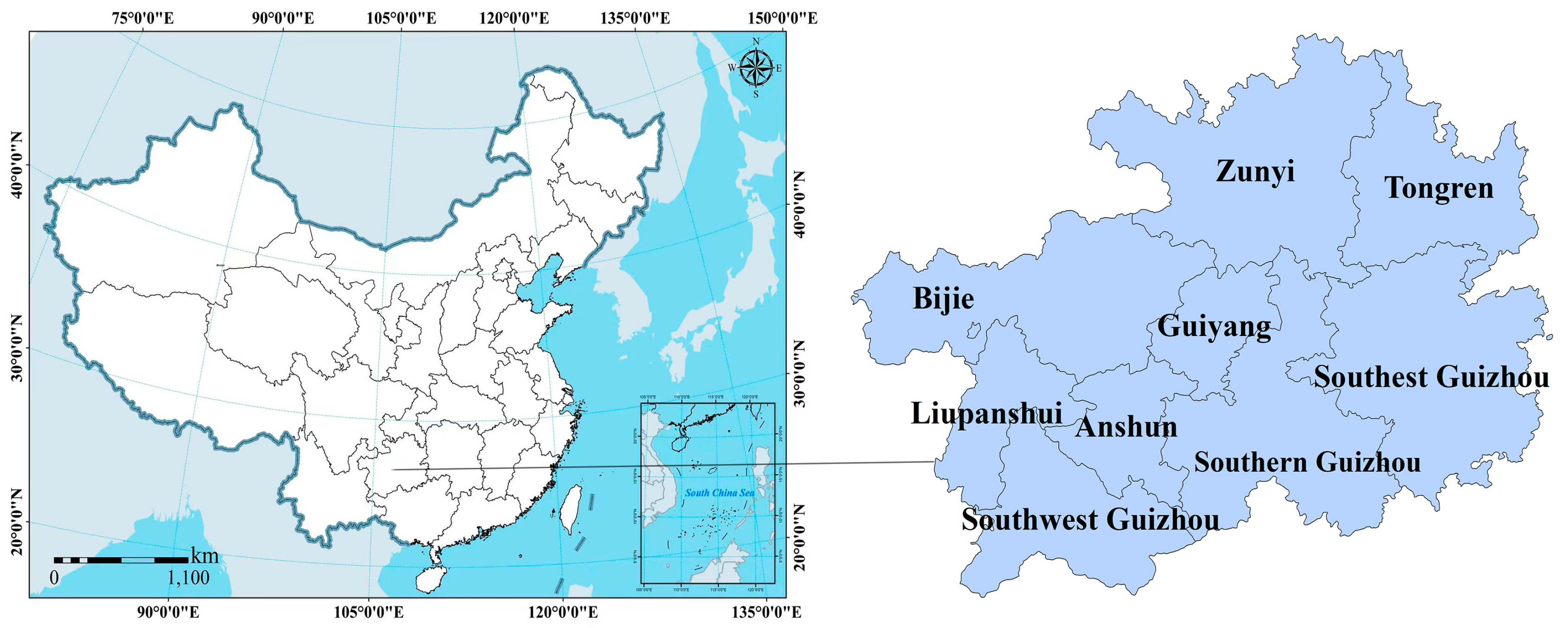
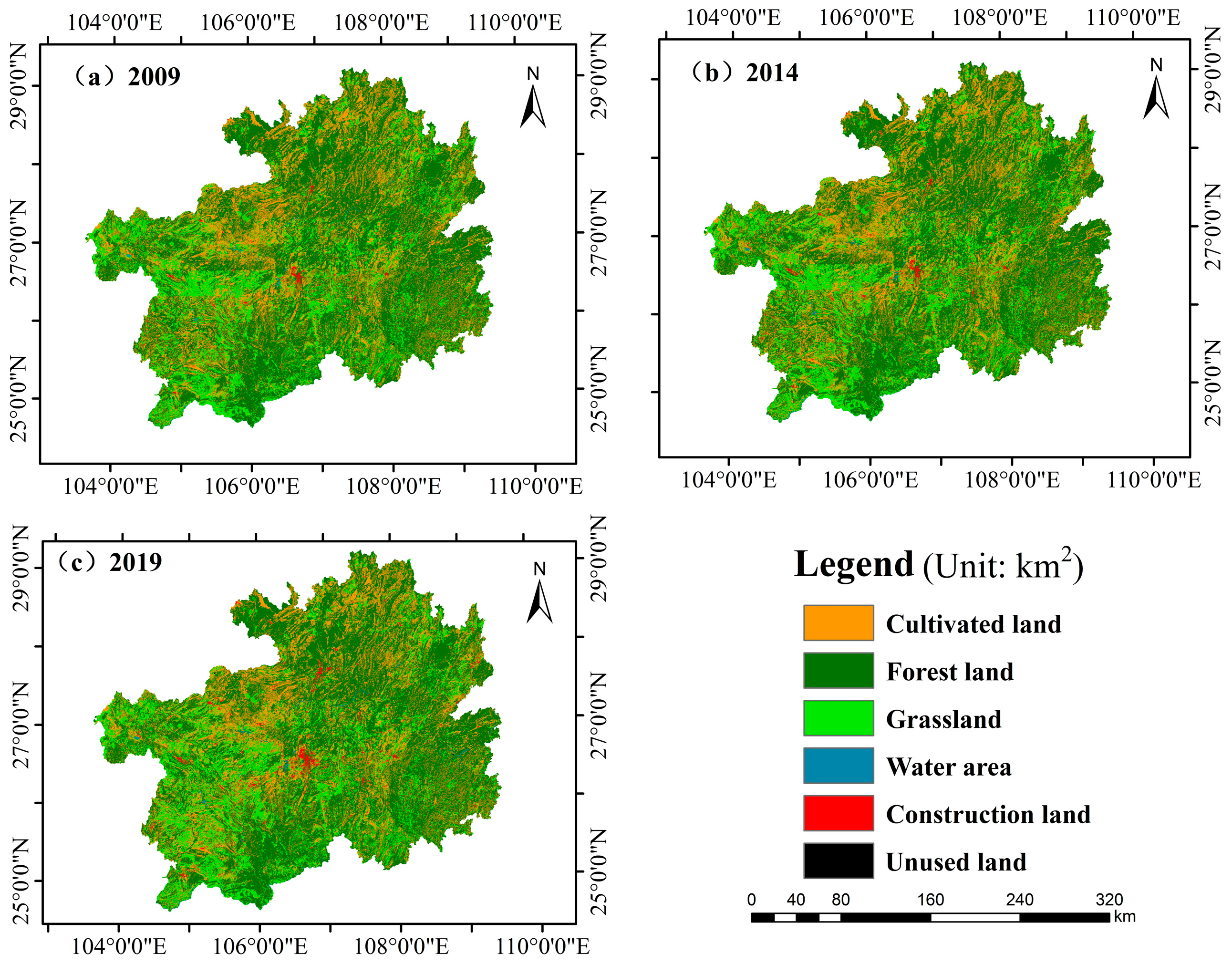

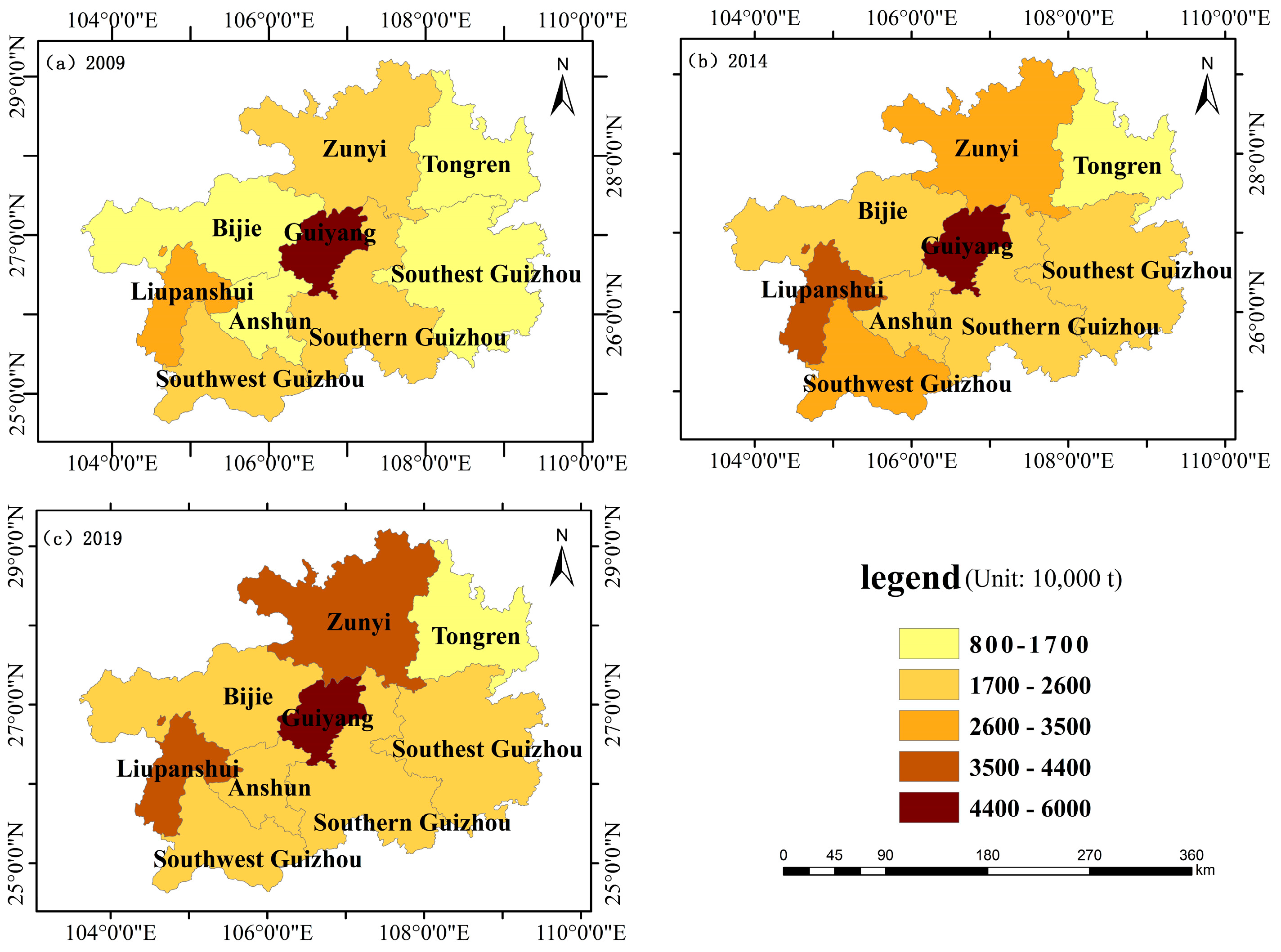
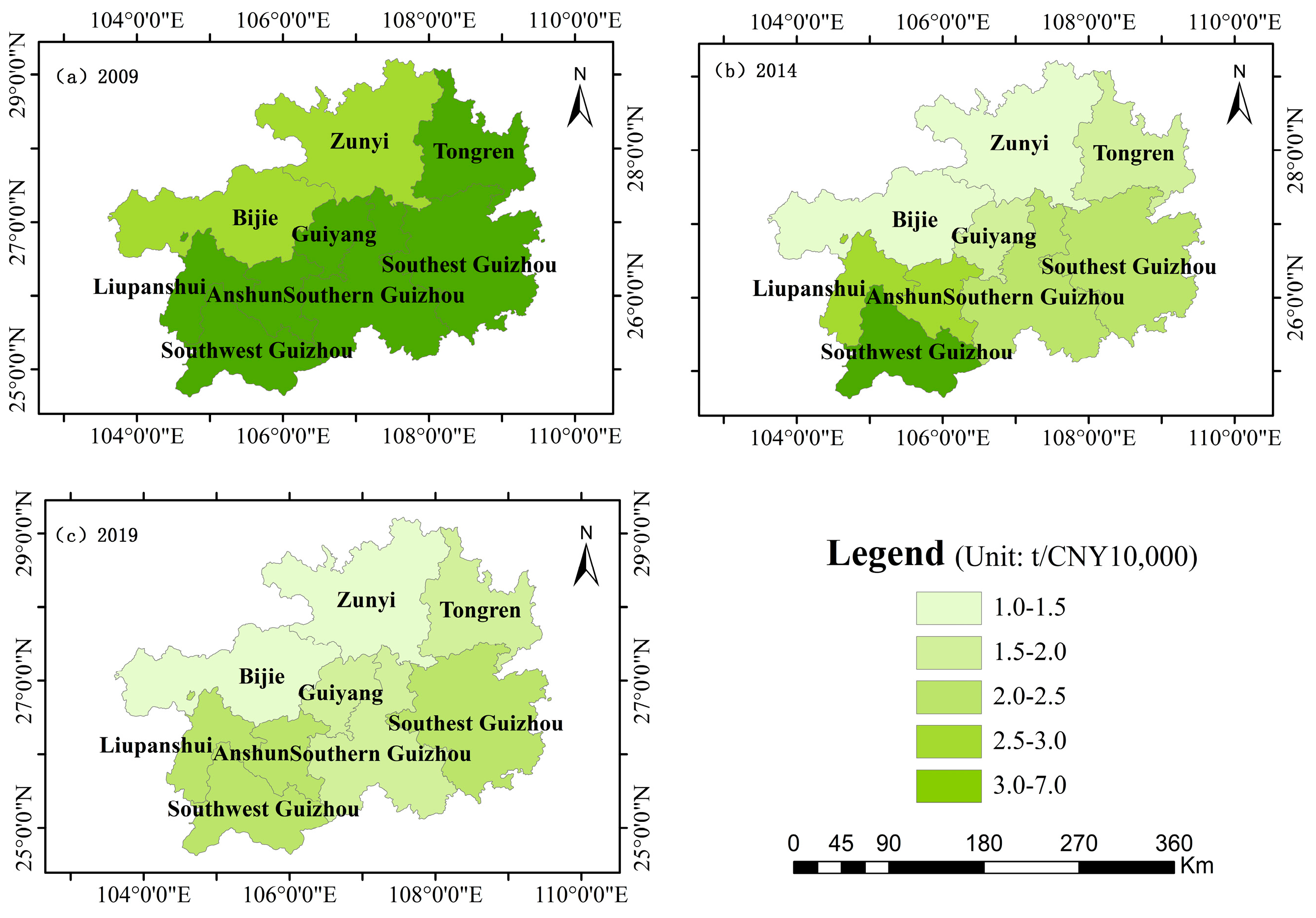

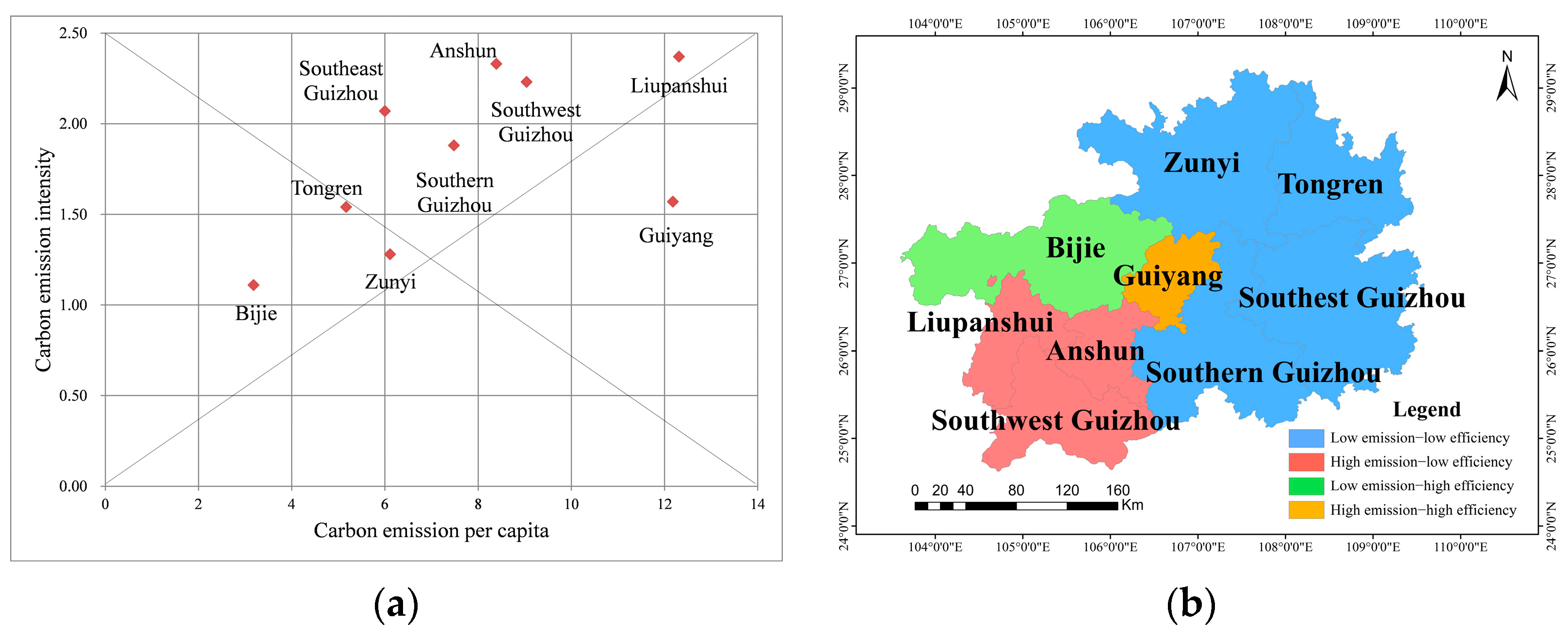
| Land Type | Coefficient Value | Unit |
|---|---|---|
| Cultivated land | 0.0422 | kg/(m2·a) |
| Forest land | −0.0578 | kg/(m2·a) |
| Grassland | −0.0021 | kg/(m2·a) |
| Water area | −0.0252 | kg/(m2·a) |
| Unused land | −0.0005 | kg/(m2·a) |
| Energy Type | Coefficient for Conversion to Standard Coal (kj·kg−1) | Average Lower Heating Value (kg·GJ−1) | Carbon Oxidation Rate (%) | Carbon Emissions Coefficient |
|---|---|---|---|---|
| Raw coal | 0.7143 | 20,908 | 95% | 0.5183 |
| Coal | 0.7143 | 20,908 | 94% | 0.7559 |
| Coke | 0.9714 | 28,435 | 93% | 0.8550 |
| Cleaned coal | 0.9000 | 26,344 | 97% | 0.6225 |
| Crude oil | 1.4286 | 41,816 | 98% | 0.5857 |
| Gasoline | 1.4714 | 43,070 | 98% | 0.5538 |
| Kerosene | 1.4714 | 43,030 | 98% | 0.5714 |
| Diesel oil | 1.4571 | 42,652 | 98% | 0.5921 |
| Liquefied petroleum gas | 1.7143 | 50,179 | 98% | 0.6225 |
| Fuel oil | 1.4286 | 41,816 | 98% | 0.6185 |
| Natural gas | 1.2143 | 35,544 | 99% | 0.4483 |
| Electric power | 0.404 | 3596 | 99% | 0.7935 |
| Year | Unit (km2) | Cultivated Land | Forest Land | Grassland | Water Area | Construction Land | Unused Land | Total |
|---|---|---|---|---|---|---|---|---|
| 2009 | Area | 49,419.82 | 95,496.35 | 29,586.67 | 686.85 | 874.54 | 29.94 | 176,094.17 |
| Proportion | 28.06% | 54.23% | 16.80% | 0.39% | 0.50% | 0.02% | 100.00% | |
| 2014 | Area | 49,087.38 | 95,423.01 | 29,529.73 | 697.75 | 1322.28 | 33 | 176,093.15 |
| Proportion | 27.88% | 54.19% | 16.77% | 0.40% | 0.75% | 0.02% | 100.00% | |
| 2019 | Area | 48,437.87 | 93,082.92 | 31,327.96 | 1045.69 | 2159.25 | 30.58 | 176,084.27 |
| Proportion | 27.51% | 52.86% | 17.79% | 0.59% | 1.23% | 0.02% | 100.00% | |
| 2009–2019 | Area change | −981.95 | −2413.43 | 1741.29 | 358.84 | 1284.71 | 0.64 | / |
| Rate of area change | −1.99% | −2.53% | 5.89% | 52.24% | 146.90% | 2.14% | / |
| Land Type | 2009–2014 | 2014–2019 | 2009–2019 |
|---|---|---|---|
| Cultivated land | −0.13% | −0.26% | −0.40% |
| Forest land | −0.02% | −0.49% | −0.51% |
| Grassland | −0.04% | 1.22% | 1.18% |
| Water area | 0.32% | 9.97% | 10.45% |
| Construction land | 10.24% | 12.66% | 29.38% |
| Unused land | 2.04% | −1.46% | 0.43% |
| Comprehensive dynamic degree | 0.13% | 0.60% | 0.64% |
| Year | Land-Use Carbon Emissions (104 t) | Total Carbon Emissions | Carbon Absorption | Net Carbon Emissions | |||||
|---|---|---|---|---|---|---|---|---|---|
| Cultivated Land | Forest Land | Grassland | Water Area | Construction Land | Unused Land | ||||
| 2009 | 208.55 | −551.97 | −6.21 | −1.73 | 5943.7 | −0.0014 | 6152.22 | −559.91 | 5592.31 |
| 3.39% | 98.58% | 1.11% | 0.31% | 96.61% | 0.00% | 100.00% | 100.00% | ||
| 2014 | 207.15 | −551.55 | −6.2 | −1.76 | 7941.6 | −0.0016 | 8148.71 | −559.51 | 7589.2 |
| 2.54% | 98.58% | 1.11% | 0.31% | 97.46% | 0.00% | 100.00% | 100.00% | ||
| 2019 | 204.41 | −538.02 | −6.58 | −2.64 | 8756.9 | −0.0015 | 8961.34 | −546.64 | 8417.7 |
| 2.28% | 98.42% | 1.20% | 0.48% | 97.72% | 0.00% | 100.00% | 100.00% | ||
| Region | GDP (CNY 108) | Carbon Emissions Intensity (t/CNY 104) | ||||
|---|---|---|---|---|---|---|
| 2009 | 2014 | 2019 | 2009 | 2014 | 2019 | |
| Guiyang | 1121.82 | 2891.16 | 3798.45 | 4.48 | 1.84 | 1.57 |
| Liupanshui | 500.63 | 1201.08 | 1525.69 | 6.93 | 2.80 | 2.37 |
| Zunyi | 908.76 | 2168.34 | 3000.23 | 2.99 | 1.43 | 1.28 |
| Anshun | 232.9 | 625.41 | 849.4 | 5.87 | 2.65 | 2.33 |
| Tongren | 293.62 | 770.89 | 1066.52 | 3.73 | 1.82 | 1.54 |
| Qianxinan Autonomous Prefecture | 307.13 | 801.65 | 1163.77 | 6.35 | 3.07 | 2.33 |
| Bijie | 600.85 | 1461.35 | 1921.43 | 2.56 | 1.28 | 1.11 |
| Qiandongnan Autonomous Prefecture | 312.57 | 811.55 | 1026.62 | 5.13 | 2.29 | 2.07 |
| Qiannan Autonomous Prefecture | 356.68 | 902.91 | 1313.46 | 5.55 | 2.35 | 1.88 |
| Region | Population (104 Person) | Carbon Emissions per Capita (t·a−1·pp) | ||||
|---|---|---|---|---|---|---|
| 2009 | 2014 | 2019 | 2009 | 2014 | 2019 | |
| Guiyang | 432.93 | 462.18 | 488.19 | 11.61 | 11.5 | 12.18 |
| Liupanshui | 285.43 | 288.99 | 293.73 | 12.15 | 11.63 | 12.31 |
| Zunyi | 613.29 | 619.21 | 627.07 | 4.42 | 5 | 6.11 |
| Anshun | 230.04 | 231.35 | 235.31 | 5.91 | 7.18 | 8.39 |
| Tongren | 309.63 | 312.24 | 316.88 | 3.51 | 4.49 | 5.17 |
| Qianxinan Autonomous Prefecture | 281.02 | 282.16 | 287.17 | 6.92 | 8.72 | 9.04 |
| Bijie | 654.57 | 660.61 | 668.61 | 2.33 | 2.82 | 3.18 |
| Qiandongnan Autonomous Prefecture | 348.52 | 348.54 | 353.83 | 4.6 | 5.33 | 6 |
| Qiannan Autonomous Prefecture | 323.51 | 324.22 | 329.21 | 6.11 | 6.54 | 7.48 |
Disclaimer/Publisher’s Note: The statements, opinions and data contained in all publications are solely those of the individual author(s) and contributor(s) and not of MDPI and/or the editor(s). MDPI and/or the editor(s) disclaim responsibility for any injury to people or property resulting from any ideas, methods, instructions or products referred to in the content. |
© 2023 by the authors. Licensee MDPI, Basel, Switzerland. This article is an open access article distributed under the terms and conditions of the Creative Commons Attribution (CC BY) license (https://creativecommons.org/licenses/by/4.0/).
Share and Cite
Li, X.; Hu, S.; Jiang, L.; Han, B.; Li, J.; Wei, X. Spatiotemporal Patterns and the Development Path of Land-Use Carbon Emissions from a Low-Carbon Perspective: A Case Study of Guizhou Province. Land 2023, 12, 1875. https://doi.org/10.3390/land12101875
Li X, Hu S, Jiang L, Han B, Li J, Wei X. Spatiotemporal Patterns and the Development Path of Land-Use Carbon Emissions from a Low-Carbon Perspective: A Case Study of Guizhou Province. Land. 2023; 12(10):1875. https://doi.org/10.3390/land12101875
Chicago/Turabian StyleLi, Xiaoping, Sai Hu, Lifu Jiang, Bing Han, Jie Li, and Xuan Wei. 2023. "Spatiotemporal Patterns and the Development Path of Land-Use Carbon Emissions from a Low-Carbon Perspective: A Case Study of Guizhou Province" Land 12, no. 10: 1875. https://doi.org/10.3390/land12101875
APA StyleLi, X., Hu, S., Jiang, L., Han, B., Li, J., & Wei, X. (2023). Spatiotemporal Patterns and the Development Path of Land-Use Carbon Emissions from a Low-Carbon Perspective: A Case Study of Guizhou Province. Land, 12(10), 1875. https://doi.org/10.3390/land12101875







